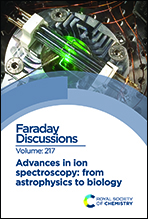Photoelectron spectra of Al2O2− and Al3O3−via slow electron velocity-map imaging†
Abstract
High-resolution photoelectron spectra of cryogenically-cooled Al2O2− and Al3O3− cluster anions are obtained using slow electron velocity-map imaging. These spectra show vibrationally-resolved detachment from the (![[X with combining tilde]](https://www.rsc.org/images/entities/char_0058_0303.gif) 2B3u) ground state of Al2O2− to the
2B3u) ground state of Al2O2− to the ![[X with combining tilde]](https://www.rsc.org/images/entities/char_0058_0303.gif) 1Ag and ã3B3u neutral electronic states, giving an electron affinity of 1.87904(4) eV for neutral Al2O2 and a term energy of 0.4938(4) eV for the triplet excited state. Additionally, there is evidence for autodetachment from photoexcited anions as well as influences from vibronic coupling between excited states of the neutral Al2O2 cluster. Detachment from both the “kite” and “book” isomers of Al3O3− is observed, yielding electron affinities of 2.0626(4) and 2.792(3) eV for the corresponding neutral isomers. Experiments carried out at different anion temperatures suggest that the two anionic isomers are nearly isoenergetic but clearly identify the kite isomer as the global minimum structure, in contrast to prior studies. This finding is supported by density functional theory calculations, which show that the relative ordering of the anion isomers is sensitive to basis set size; calculations for the anion isomers at the B3LYP/aug-cc-pVQZ level find the kite isomer to lie 0.011 eV below the book isomer.
1Ag and ã3B3u neutral electronic states, giving an electron affinity of 1.87904(4) eV for neutral Al2O2 and a term energy of 0.4938(4) eV for the triplet excited state. Additionally, there is evidence for autodetachment from photoexcited anions as well as influences from vibronic coupling between excited states of the neutral Al2O2 cluster. Detachment from both the “kite” and “book” isomers of Al3O3− is observed, yielding electron affinities of 2.0626(4) and 2.792(3) eV for the corresponding neutral isomers. Experiments carried out at different anion temperatures suggest that the two anionic isomers are nearly isoenergetic but clearly identify the kite isomer as the global minimum structure, in contrast to prior studies. This finding is supported by density functional theory calculations, which show that the relative ordering of the anion isomers is sensitive to basis set size; calculations for the anion isomers at the B3LYP/aug-cc-pVQZ level find the kite isomer to lie 0.011 eV below the book isomer.

- This article is part of the themed collection: Advances in ion spectroscopy - from astrophysics to biology


 Please wait while we load your content...
Please wait while we load your content...
